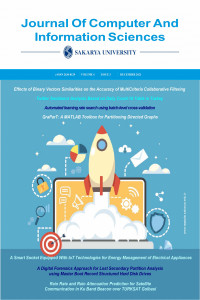Rain Rate and Rain Attenuation Prediction For Satellite Communication in Ku Band Beacon Over TURKSAT Golbası
Abstract
Satellite beacon is a signal which does not modulated and sent to ground in constant frequency with a specific designed power. Beacon signals are used by ground station antenna users track the satellite easily. The satellite operators generally choose beacon signal at Ku Band frequency band since this band is more resistant to rain attenuation. Ku band satellite system performance describe by the contribute of rainfall rate and rain attenuation. This paper includes the comparison of rain attenuation in Ku band beacon and taking as a reference ITU – 838 model caused by rain fall rate in TURKSAT premises. It is compared by calculating that how signals affected from rain between 2012, and 2019 observations for a TURKSAT satellite and in this measurement both theoretical formula and data are used.
References
- [1] Hui Y.L. Dr et al., Sain W. K., Sin Y.L., Overcoming Rain Fade Obstacle-Understanding Singapore’s Rain Dynamics and Feasible Countermeasures Against Rain Fading-DSTA Horizons (6-15).
- [2] Mandeep S.J., Allnut, E.J., (2007) Rain attenation Predictions at Ku-Band in South East Asia Countries: Progress in Electromagnetics Research, PIER 76, 65–74.
- [3] Ameen H.J.J., (2015, May) Rain effect on Ku Band satellite system: Electrical and Electronics Engineering: An International Journal (ELELIJ) Vol 4, No 2.
- [4] Türksat Satellite Communication and Cable TV Operation AS. / Ground Stations / Document: 2012-2019 11.120 GHz Ku band beacon telemetry information.
- [5] Charlesworth, P. (2010, 2015) Notes on a Technıque to estimate Rain Margins/ University of Wales/
- [6] Specific attenuation model for rain for use in prediction methods (2005, September, 29), E27367 (03-05): RECOMMENDATION ITU-R P.838-3.
- [7] Propagation data and prediction methods required for the design of Earth-space telecommunication systems (2015, August, 11), E70000, (206/3): RECOMMENDATION ITU-R P.618-12.
- [8] Abdulrahman Y.A, Rahman A.T., Rahim A.K.S. (2010) A new Rain Attenuation Conversion Technique for Tropical Regions: Progress in Electromagnetics Research B, no. 26, pp. 53–67.
- [9] Amount of rain year, day and hours (2012, 2014): Turkish State Meteorological Service Department of Gölbaşı: Station no: 17134.
- [10] Kestwal. C.M. , Joshi S., and Garia S.L.(2014,June,11) Prediction of Rain Attenuation and Impact of Rain in Wave Propagation at Microwave Frequency for Tropical Region (Uttarakhand, India): International Journal of Microwave Science and Technology Volume 2014, ID 958498, pp.6
Abstract
Supporting Institution
TÜRKSAT UYDU HABERLEŞME KABLO TV VE İŞLETME A.Ş.
Thanks
Türksat A.Ş.'ye verdiği değerli destek için teşekkür ederiz.
References
- [1] Hui Y.L. Dr et al., Sain W. K., Sin Y.L., Overcoming Rain Fade Obstacle-Understanding Singapore’s Rain Dynamics and Feasible Countermeasures Against Rain Fading-DSTA Horizons (6-15).
- [2] Mandeep S.J., Allnut, E.J., (2007) Rain attenation Predictions at Ku-Band in South East Asia Countries: Progress in Electromagnetics Research, PIER 76, 65–74.
- [3] Ameen H.J.J., (2015, May) Rain effect on Ku Band satellite system: Electrical and Electronics Engineering: An International Journal (ELELIJ) Vol 4, No 2.
- [4] Türksat Satellite Communication and Cable TV Operation AS. / Ground Stations / Document: 2012-2019 11.120 GHz Ku band beacon telemetry information.
- [5] Charlesworth, P. (2010, 2015) Notes on a Technıque to estimate Rain Margins/ University of Wales/
- [6] Specific attenuation model for rain for use in prediction methods (2005, September, 29), E27367 (03-05): RECOMMENDATION ITU-R P.838-3.
- [7] Propagation data and prediction methods required for the design of Earth-space telecommunication systems (2015, August, 11), E70000, (206/3): RECOMMENDATION ITU-R P.618-12.
- [8] Abdulrahman Y.A, Rahman A.T., Rahim A.K.S. (2010) A new Rain Attenuation Conversion Technique for Tropical Regions: Progress in Electromagnetics Research B, no. 26, pp. 53–67.
- [9] Amount of rain year, day and hours (2012, 2014): Turkish State Meteorological Service Department of Gölbaşı: Station no: 17134.
- [10] Kestwal. C.M. , Joshi S., and Garia S.L.(2014,June,11) Prediction of Rain Attenuation and Impact of Rain in Wave Propagation at Microwave Frequency for Tropical Region (Uttarakhand, India): International Journal of Microwave Science and Technology Volume 2014, ID 958498, pp.6
Details
| Primary Language | English |
|---|---|
| Subjects | Communication and Media Studies |
| Journal Section | Articles |
| Authors | |
| Publication Date | December 31, 2021 |
| Submission Date | August 4, 2021 |
| Acceptance Date | December 13, 2021 |
| Published in Issue | Year 2021 Volume: 4 Issue: 3 |
Cite
Cited By
Realistic Prognostic Modeling of Specific Attenuation due to Rain at Microwave Frequency for Tropical Climate Region
Wireless Communications and Mobile Computing
https://doi.org/10.1155/2022/8209256
The papers in this journal are licensed under a Creative Commons Attribution-NonCommercial 4.0 International License


